Czech koruna
The koruna (sign: Kč; code: CZK) is the currency of the Czech Republic since 1993. The koruna is one of European Union's 11 currencies, and Czechia is legally bound to adopt the euro currency in the future.
| Czech koruna | |||||
|---|---|---|---|---|---|
| koruna česká (Czech) | |||||
| |||||
| ISO 4217 | |||||
| Code | CZK | ||||
| Number | 203 | ||||
| Exponent | 2 | ||||
| Denominations | |||||
| Subunit | |||||
| 1⁄100 | haléř (defunct) | ||||
| Plural | The language(s) of this currency belong(s) to the Slavic languages. There is more than one way to construct plural forms. | ||||
| Symbol | Kč | ||||
| haléř (defunct) | h | ||||
| Banknotes | |||||
| Freq. used | 100, 200, 500, 1000, 2000 Kč | ||||
| Rarely used | 5000 Kč | ||||
| Coins | 1, 2, 5, 10, 20, 50 Kč | ||||
| Demographics | |||||
| User(s) | |||||
| Issuance | |||||
| Central bank | Czech National Bank | ||||
| Website | www | ||||
| Mint | Česká mincovna | ||||
| Website | ceskamincovna.cz | ||||
| Valuation | |||||
| Inflation | 2.5% | ||||
| Source | Czech Statistical Office, February 2017 | ||||
| Method | CPI | ||||
The official name in Czech is koruna česká (plural koruny české, though the zero-grade genitive plural form korun českých is used on banknotes and coins of value 5 Kč or higher). The ISO 4217 code is CZK and the local acronym is Kč, which is placed after the numeric value (e.g., "50 Kč") or sometimes before it (as is seen on the 10-koruna coin). One koruna equals 100 haléřů (abbreviated as "h", singular: haléř, nominative plural: haléře, genitive plural: haléřů – used with numbers higher or equal to 5 – e.g. 3 haléře, 8 haléřů), but haléře have been withdrawn, and the smallest unit of physical currency is 1 Kč.
History
In 1892, the Austro-Hungarian krone replaced the gulden, at the rate of one gulden equaling two kronen (which is also the reason why the 10-koruna coin had been nicknamed pětka or "the five" by the Czechs even long time after the empire fell apart). The name "krone" was invented by the emperor, Franz Joseph I of Austria. After Austria-Hungary dissolved in 1918, the only successor state that kept the name of the currency, the koruna, was Czechoslovakia. In the late 1920s, the Czechoslovak koruna was the hardest currency in Europe. During the Second World War, the currency on the occupied Czech territory was artificially weakened. The Czechoslovak koruna was restored after the war. It underwent a highly controversial monetary reform in 1953.
The Czech koruna replaced the Czechoslovak koruna when it was introduced in 1993 after the dissolution of Czechoslovakia. It first consisted of overstamped 20-, 50-, 100-, 500-, and 1000-Czechoslovak koruna banknotes, but a new series was properly introduced in 1993.
In November 2013, the Czech National Bank (ČNB) intervened to weaken the exchange rate of the koruna through a monetary stimulus to stop the currency from excessive strengthening.[1] This was meant to support the Czech economy, mainly focused on export, but people were unhappy about this step because it was set up before Christmas, which led to raising the prices of imported goods. In late 2016, the ČNB stated that the return to conventional monetary policy was planned for mid-2017.[2][3] After higher-than-expected inflation and other figures, the national bank removed the cap at a special monetary meeting on April 6, 2017. The koruna avoided significant volatility and City Index Group stated: "If you want to drop a currency peg, then the ČNB can show you how to do it".[4]
Euro adoption discussion
The Czech Republic planned to adopt the euro in 2010, but its government suspended that plan indefinitely in 2005.[5] Although the country is economically well positioned to adopt the euro, there is considerable opposition to the move within the Czech Republic.[6] According to a survey conducted in April 2014, only 16% of the Czech population was in favour of replacing the koruna with the euro.[7] As reported by an April 2018 survey by CVVM (Public Opinion Research Center), this value has remained at nearly identical levels over the past four years, with only 20% of the Czech population above 15 years old supporting euro adoption.[8]
Coins
The coins of the Czech koruna increase in size and weight with value.
In 1993, coins were introduced in denominations of 10, 20 and 50 haléřů, 1, 2, 5, 10, 20 and 50 korun. The 10- and 20-haléřů coins were taken out of circulation by 31 October 2003 and the 50-haléřů coins by 31 August 2008 due to their diminishing purchasing power and circulation.[9] However, financial amounts are still written with the accuracy of 1-haléř (CZK 0.01); prices in retail shops are usually multiples of CZK 0.10. When transactions are made, the amount is rounded to the nearest integer.
In 2000, the 10- and 20-korun coins were minted with different obverses to commemorate the millennium. In 1993 and 1994, coins were minted in Winnipeg and Hamburg, then in the Czech Republic. The 10- and 50-korun coins were designed by Ladislav Kozák (1934–2007).
Since 1997, sets for collectors are also issued yearly with proof-quality coins. Also, a tradition exists of issuing commemorative coins – including silver and gold coins – for numismatic purposes.
For a complete listing, see Commemorative coins of the Czech Republic.
| Circulation coins[10] | ||||||||||||
|---|---|---|---|---|---|---|---|---|---|---|---|---|
| Image | Value | Technical parameters | Description | Date of | ||||||||
| Diameter | Thickness | Mass | Composition | Edge | Obverse | Reverse | first minting | issue | withdrawal | |||
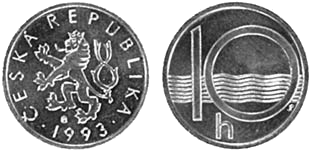 |
10 h | 15.5 mm | 1.7 mm | 0.6 g | 99% aluminium 1% magnesium |
Plain | "ČESKÁ REPUBLIKA", the Czech lion, year of minting | Value, stylized river | 1993 | 1993 | 2003 | |
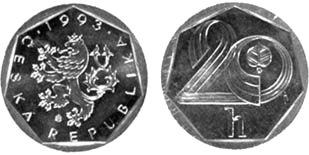 |
20 h | 17 mm | 0.74 g | Milled | Value, linden leaf | 1993 | 1993 | 2003 | ||||
 |
50 h | 19 mm | 0.9 g | Alternately plain and milled | Value | 1993 | 1993 | 2008 | ||||
 |
1 Kč | 20 mm | 1.85 mm | 3.6 g | Nickel-plated steel | Milled | Value, St. Wenceslas crown | 1993 | 1993 | Current | ||
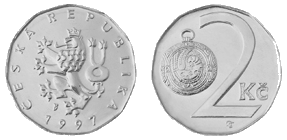 |
2 Kč | 21.5 mm, 11-sided |
3.7 g | Rounded, plain | Value, a Great Moravian button-jewel | 1993 | 1993 | Current | ||||
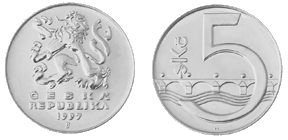 |
5 Kč | 23 mm | 4.8 g | Plain | Value, Charles Bridge, Vltava, linden leaf | 1993 | 1993 | Current | ||||
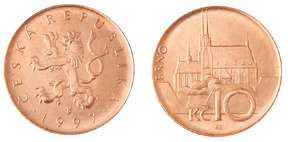 |
10 Kč | 24.5 mm | 2.55 mm | 7.62 g | Copper-plated steel | Milled | Value, Cathedral of St. Peter and Paul at Petrov monument in Brno | 1993 | 1993 | Current | ||
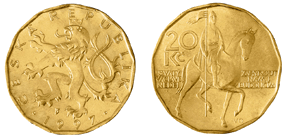 |
20 Kč | 26 mm, 13-sided |
8.43 g | Brass-plated steel | Rounded, plain | Value, the St. Wenceslas monument on Wenceslas Square, inscription from the monument: "SVATÝ VÁCLAVE NEDEJ ZAHYNOUT NÁM I BUDOUCÍM" | 1993 | 1993 | Current | |||
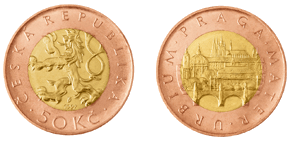 |
50 Kč | 27.5 mm center: 17 mm |
9.7 g | Outer ring: Copper-plated steel Center plug: Brass-plated steel |
Plain | "PRAGA MATER URBIUM" (Prague, the Mother of Towns), view of Prague | 1993 | 1993 | Current | |||
Banknotes
The first Czech banknotes were issued on 8 February 1993 and consisted of Czechoslovak notes with adhesive stamps affixed to them. Only the 100-, 500- and 1,000-korun notes were overstamped, the lower denominations circulated unchanged during this transitional period. Each stamp bears a Roman and Arabic numeral identifying the denomination of the banknote to which it is affixed (C and 100, D and 500, M and 1,000). Subsequent issues of the 1,000-korun note replaced the adhesive stamp with a printed image of same.[11]
A newly designed series of banknotes in denominations of 20-, 50-, 100-, 200-, 500-, 1,000 and 5,000-korun were introduced later in 1993 and are still in use at present – except for 20, 50 and the first versions of 1,000 and 5,000 korun notes, since the security features of 1,000 and 5,000 notes were upgraded in the subsequent issues (The 2,000 korun note, which was introduced in 1996, is still valid in all versions, with and without the new security features). These banknotes feature renowned Czech persons on the obverse and abstract compositions on the reverse. Modern protective elements can be found on all banknotes.
Stamped banknotes
| Image | Value | Dimensions | Main Colour | Language | Description | Date of | ||||
|---|---|---|---|---|---|---|---|---|---|---|
| Obverse | Reverse | Obverse | Reverse | printing | issue | withdrawal | ||||
| Czechoslovak banknotes | ||||||||||
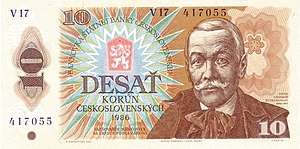 |
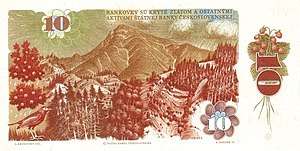 |
10 Kčs | 133 × 67 mm | Brown | Slovak | Pavol Országh-Hviezdoslav | Orava scene | 1986 | 7 February 1993 | 31 July 1993 |
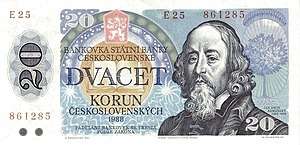 |
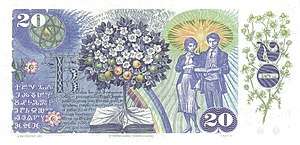 |
20 Kčs | 138 × 67 mm | Blue | Czech | Comenius | Illustration related to culture and education | 1988 | 7 February 1993 | 31 July 1993 |
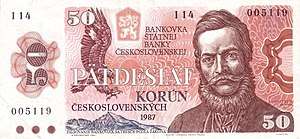 |
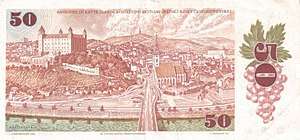 |
50 Kčs | 143 × 67 mm | Red | Slovak | Ľudovít Štúr | View of Bratislava with the castle (from the restaurant on the top of the pylon of the Nový Most) | 1987 | 7 February 1993 | 31 July 1993 |
| Overstamped Czechoslovak banknotes | ||||||||||
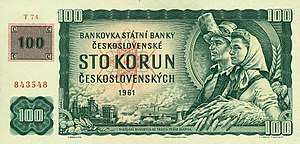 |
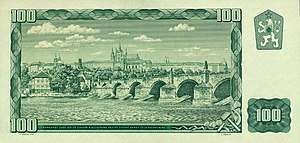 |
100 Kč | 165 × 81 mm | Green | Czech | Peasant couple | View of Prague with the castle and the Charles Bridge | 1961 | 7 February 1993 | 31 August 1993 |
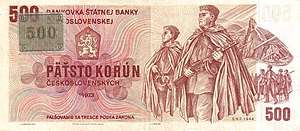 |
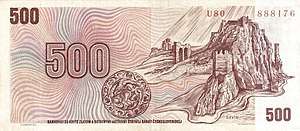 |
500 Kč | 153 × 67 mm | Brown | Slovak | Partisans of the SNP 1944 | Devín Castle | 1973 | 7 February 1993 | 31 August 1993 |
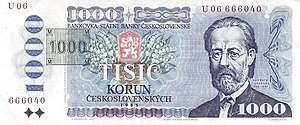 |
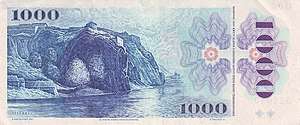 |
1,000 Kč | 158 × 67 mm | Blue | Czech | Bedřich Smetana | View of the Vltava at Vyšehrad | 1985 | 7 February 1993 | 31 August 1993 |
Original Czech banknotes
The Greater coat of arms of the Czech Republic can be found on the reverse side of all denominations.
| Value | Dimensions | Main Colour | Description | Date of | ||||
|---|---|---|---|---|---|---|---|---|
| Obverse | Reverse | printing | issue | withdrawal | lapse | |||
| First original (second 1993) series | ||||||||
| 20 Kč | 128 × 64 mm | Blue | Přemysl Otakar I and his seal | Crown | 1994 | 20 April 1994 | 31 August 2008 | 31 August 2014[12] |
| 50 Kč | 134 × 64 mm | Red | Saint Agnes of Bohemia and the Sacred Heart | St. Salvator's Church ceiling (part of Convent of St. Agnes of Bohemia in Prague) and ornamental letter A | 1993 | 6 October 1993 | 31 January 2007 | 31 March 2017[13] |
| 1994 | 21 December 1994 | 31 March 2011 | ||||||
| 1997 | 10 September 1997 | 31 March 2011 | ||||||
| 100 Kč | 140 × 69 mm | Green and pink | Charles IV | Seal of Charles University | 1993 | 30 June 1993 | 31 January 2007 | until further notice |
| 1995 | 21 June 1995 | current | ||||||
| 1997 | 15 October 1997 | current | ||||||
| 200 Kč | 146 × 69 mm | Brown and orange | John Amos Comenius | Orbis Pictus, an adult's hand passing to a child's hand | 1993 | 8 February 1993 | 31 January 2007 | until further notice |
| 1996 | 14 August 1996 | current | ||||||
| 1998 | 6 January 1999 | current | ||||||
| 500 Kč | 152 × 69 mm | Brown and pink | Božena Němcová and rose | Laureate woman symbolizing all woman characters in Němcová's books | 1993 | 21 July 1993 | 31 January 2007 | until further notice |
| 1995 | 27 December 1995 | current | ||||||
| 1997 | 18 March 1998 | current | ||||||
| 2009 | 1 April 2009 | current | ||||||
| 1,000 Kč | 158 × 74 mm | Violet | František Palacký, uprooted tree | Eagle spread its wings over the Archbishop's Castle in Kroměříž, where a constitution preparing parliament of Austrian Empire was held in 1848 | 1993 | 12 May 1993 | 30 June 2001 | until further notice |
| 1996 | 6 December 1996 | current | ||||||
| 2008 | 1 April 2008 | current | ||||||
| 2,000 Kč | 164 × 74 mm | Green | Emmy Destinn | Euterpe and musical motifs like violin | 1996 | 1 October 1996 | current | |
| 1999 | 1 December 1999 | current | ||||||
| 2007 | 2 July 2007 | current | ||||||
| 5,000 Kč | 170 × 74 mm | Dark blue and violet | Tomáš Garrigue Masaryk | Gothic and Baroque buildings in Prague, in centre dominating St. Vitus Cathedral | 1993 | 15 December 1993 | 30 June 2001 | until further notice |
| 1999 | 8 September 1999 | current | ||||||
| 2009 | 1 December 2009 | current | ||||||
Commemorative banknotes
| Image | Value | Dimensions | Description | Date of | |||||||
|---|---|---|---|---|---|---|---|---|---|---|---|
| Obverse | Reverse | Obverse | Reverse | Watermark | printing* | issue | withdrawal | lapse | |||
 |
 |
100 Kč | 150 × 65 mm | Alois Rašín | Czech National Bank | RČS | 2019 | 25 February 2019 | TBD | ||
| 100 Kč Green and pink | 140 × 69 mm | Charles IV, overprint on watermark area | Seal of Charles University | TBD | |||||||
For the 100th anniversary of the Czechoslovak koruna, a new banknote will be created, featuring the face of Czech politician Alois Rašín. There is also an overprint on the normal 100 Korun note as second commemorative note.
Exchange rates
Historic rates
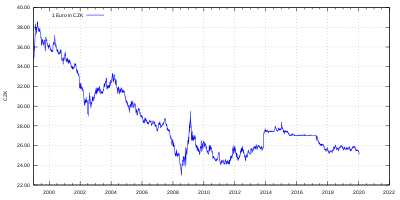 EUR–CZK exchange rate since 1999 The currency was on a record exchange rate run in 2008.[15] Most traded currencies (since 31 December 2008):
Source: Czech National Bank exchange rates [16] |
Current rates
| Current CZK exchange rates | |
|---|---|
| From Google Finance: | AUD CAD CHF EUR GBP HKD JPY USD |
| From Yahoo! Finance: | AUD CAD CHF EUR GBP HKD JPY USD |
| From XE.com: | AUD CAD CHF EUR GBP HKD JPY USD |
| From OANDA: | AUD CAD CHF EUR GBP HKD JPY USD |
| From fxtop.com: | AUD CAD CHF EUR GBP HKD JPY USD |
See also
- Bohemian and Moravian koruna
- Czechoslovak koruna
- Slovak koruna
- Commemorative coins of the Czech Republic
- Czech Republic and the euro
- Economy of the Czech Republic
References
- "Czech Koruna Approaches Euro Cap: Intervention Policy Explained". 8 July 2015. Archived from the original on 15 December 2017. Retrieved 4 May 2018 – via www.bloomberg.com.
- "Czech Central Bank Zeros In on Ending Koruna Cap in Mid-2017". 29 September 2016. Archived from the original on 19 January 2018. Retrieved 4 May 2018 – via www.bloomberg.com.
- "Czech Central Banker Quashes Bets on Earlier Koruna Cap Exit". 13 September 2016. Archived from the original on 17 February 2018. Retrieved 4 May 2018 – via www.bloomberg.com.
- "Czechs Trigger Long-Awaited Koruna Float Without Swiss Shock". 6 April 2017. Archived from the original on 18 June 2017. Retrieved 4 May 2018 – via www.bloomberg.com.
- "Finance Ministry backtracks on joining the Euro by 2012". Radio Praha. Archived from the original on 7 February 2009. Retrieved 22 December 2008.
- "Euros in the wallets of the Slovaks, but who will be next?" (Press release). Sparkasse.at. 5 August 2008. Archived from the original on 4 September 2006. Retrieved 21 December 2008.
- "Archived copy" (PDF). Archived (PDF) from the original on 13 August 2014. Retrieved 11 August 2014.CS1 maint: archived copy as title (link)
- "Archived copy" (PDF). Retrieved 28 November 2018.
- "The CNB decides 50-heller coins will cease to be legal tender". Archived from the original on 14 April 2008. Retrieved 20 January 2008.
- Czech national bank. Available at: "Archived copy". Archived from the original on 5 September 2013. Retrieved 28 August 2013.CS1 maint: archived copy as title (link)
- "Platidla ČR (1993–20..) – Papírová platidla, bankovky". Papirovaplatidla.cz. Archived from the original on 16 November 2014. Retrieved 19 August 2014.
- "ČNB". www.cnb.cz. Archived from the original on 4 May 2018. Retrieved 4 May 2018.
- "Czech Republic to replace 50-koruna note with coin 01.04.2011 - Banknote News". banknotenews.com. Archived from the original on 25 August 2014. Retrieved 4 May 2018.
- "Rašín Alois". zlate-mince.cz. Zlatemince.cz. Retrieved 6 July 2018.
- "Czech crown extends record run, eyes on CPI". Forbes. 7 July 2008. Archived from the original on 4 June 2011.
- Czech national bank exchange rate fixing. Available at: "Exchange rates – yearly history". Retrieved 20 February 2020.
External links
| Wikimedia Commons has media related to Money of the Czech Republic. |
- Czech banknotes, Czech National Bank
- Czech coins, Czech National Bank
- Czech banknotes (catalog, gallery and other details, history)
- Heiko Otto (ed.). "Historical and current banknotes of the Czech Republic" (in English, German, and French). Retrieved 6 June 2019.
- Heiko Otto (ed.). "Historical banknotes of Czechoslovakia" (in English, German, and French). Retrieved 6 June 2019.

